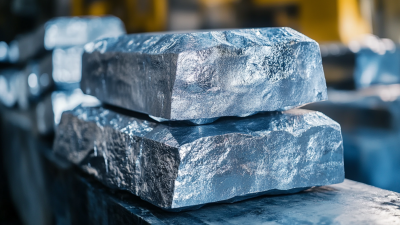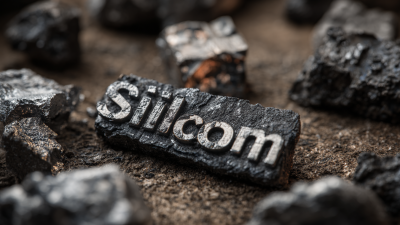Leave Your Message
The demand for Metallic Silicon has surged in recent years, driven by its critical applications in various industries, including electronics, solar energy, and aluminum alloy production. According to a report by Grand View Research, the global market for Metallic Silicon is projected to reach $6.45 billion by 2025, growing at a compound annual growth rate (CAGR) of 8.2%. This increasing demand has led global buyers to seek comprehensive insights into the performance and pricing of different grades of Metallic Silicon. Understanding the distinctions in grade quality, such as purity levels and crystalline structure, is essential for optimizing end-use applications and making informed purchasing decisions. In this tutorial, we will explore the various grades of Metallic Silicon available in the market, compare their performance metrics, and analyze pricing trends to equip buyers with the knowledge necessary for navigating this competitive landscape.

The global silicon metal market is poised for significant growth, with projections indicating a rise from USD 7.82 billion in 2024 to USD 10.76 billion by 2031. This surge, reflecting a compound annual growth rate (CAGR) of 4.66%, highlights the increasing demand for various grades of metallic silicon across multiple industries. Understanding the different grades of silicon metal is crucial for buyers, as each grade serves specific applications, influencing both performance and pricing.
Different grades of metallic silicon, ranging from 98% to 99.9% purity, cater to distinct sectors such as aluminum production, chemical manufacturing, and solar photovoltaic cells. Higher purity grades are essential for applications that require superior electrical conductivity and reduced impurities, whereas lower grades are typically sufficient for less demanding uses. As industries evolve and seek optimized materials, an understanding of these grades helps global buyers make informed decisions and align their purchasing strategies with market trends.
This chart compares the performance and pricing of various grades of metallic silicon used in different applications. The x-axis represents different grades, while the y-axis shows both the price per ton and the thermal conductivity (for performance) of each grade.
The global market for metallic silicon is poised for significant growth, with an estimated value of 757.4 tons in 2023. Projections indicate that this figure will rise to 865.5 tons by 2024 and is expected to reach an impressive 2,582.0 tons by 2032. This growth trajectory underscores the increasing demand for silicon in various applications, particularly as the semiconductor industry continues to advance.

Key factors influencing the pricing of metallic silicon in the global market include the fluctuations in raw material costs, technological advancements in silicon production, and the evolving landscape of demand driven by innovative applications such as solar energy and electric vehicles. For instance, the market for silicon epitaxial (EPI) wafers is projected to be valued at $1.6 billion by 2024, with a compound annual growth rate exceeding 13.2% between 2025 and 2034. This surge can largely be attributed to the rising demand for advanced semiconductor devices, further emphasizing the critical role of metallic silicon in powering technological progress.
As the marketplace evolves, buyers must remain vigilant about these pricing factors and developments to make informed purchasing decisions in an increasingly competitive and dynamic environment. The ongoing advancements in green finance and carbon trading also hint at a transformation of market structures, potentially impacting silicon pricing and availability.
In the ever-evolving semiconductor market, the performance metrics of various metallic silicon grades play a crucial role in determining their suitability for global buyers. High-purity silicon, often known as 99.9999% or six-nines silicon, typically presents superior performance in electronic applications due to its enhanced conductivity and reduced impurity levels. Industry reports indicate that the global demand for high-purity silicon has increased by 15% annually, driven by advancements in solar cell technology and semiconductor manufacturing processes.
On the other hand, lower grades of silicon, such as metallurgical or polysilicon grades, offer different benefits. While they may contain higher impurity levels, these grades are significantly less expensive, making them attractive for applications where cost-efficiency is paramount. According to a recent market analysis, the pricing for metallurgical silicon stands at approximately $1,200 per metric ton, compared to $3,500 for high-purity silicon. This stark difference highlights the trade-off between performance and cost, ultimately guiding buyers in selecting the appropriate grade based on their specific application needs. Understanding these performance metrics and pricing dynamics is essential for stakeholders navigating this complex marketplace.
| Silicon Grade | Purity (%) | Typical Applications | Performance Metric (W/m·K) | Price ($/kg) |
|---|---|---|---|---|
| Solar Grade Silicon | 99.9999 | Photovoltaic cells | 150 | 5.00 |
| Metal Grade Silicon | 98.0 | Aluminum alloys, chemical production | 100 | 2.50 |
| High Purity Silicon | 99.999999 | Semiconductors, electronics | 200 | 15.00 |
| Ferro Silicon | 75.0 | Steel production, alloying agent | 80 | 1.20 |
| Silicon Metal | 98.5 | Chemical and electrical industries | 90 | 3.00 |
As global buyers of metallic silicon navigate a complex landscape shaped by ever-evolving market dynamics, strategic sourcing becomes crucial. Recent trends indicate significant pressures in the silica market, with supply-demand imbalances aggravating challenges for stakeholders. Reports suggest that the global silica and silicon coal market could face tighter supply conditions by mid-2025, pointing to the necessity for buyers to focus on reliable suppliers with robust sourcing strategies.

In addition, trade barriers in the EU and US seem unlikely to dramatically alter silicon metal prices, offering a unique opportunity for buyers to assess their procurement strategies in light of evolving global trade policies. The ongoing operational adjustments by key producers, particularly in China's varying regional landscapes, are also essential for buyers to consider. With northern regions maintaining stable production rates, buyers should develop relationships with suppliers who can leverage local advantages while ensuring consistency in quality and pricing.
Lastly, the polysilicon market continues to grapple with oversupply and pessimism among buyers. Data from industry analyses emphasize that this oversupply, driven by excess production capabilities, may create additional leverage for buyers seeking to negotiate competitive pricing while ensuring their supply chains remain resilient amidst global fluctuations. Adapting sourcing strategies in response to these trends will be vital for maintaining a competitive edge in the metallic silicon market.
Emerging trends in metallic silicon production reveal a dynamic landscape, especially as the demand for silicon metal surges in key industries. In June 2025, China's silicon metal production rose by 6.5%, reaching 327,700 metric tons, reflecting the robust demand driven by the growing electric vehicle (EV) sector and solar energy applications. As industries increasingly rely on silicon for alloys, semiconductors, and renewable energy technologies, the usage of this material is projected to escalate.
However, the market faced significant challenges, as noted by the decline in spot silicon prices leading up to early March 2025. For instance, SMM's above-standard #553 silicon witnessed a decline of 250 yuan/mt month-over-month, a trend indicative of broader supply-demand imbalances. As the year progressed, silicon metal prices rebounded in late June, suggesting a potential stabilization.
Interestingly, data shows that while prices in China cooled during the pre-Lunar New Year period, markets in the US and Europe experienced growth, highlighting divergent pricing trends globally. This disparity underscores the complexities of global market dynamics, where regional demands and production capacities play crucial roles.






